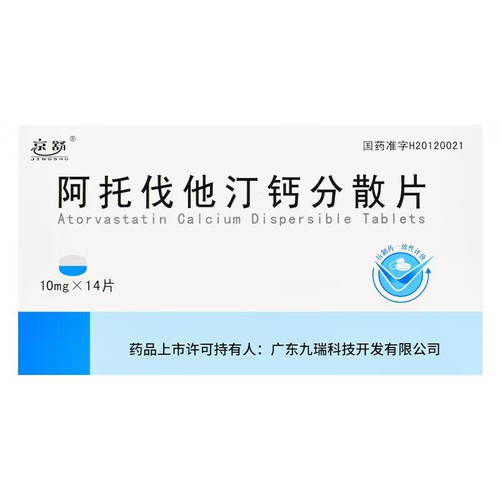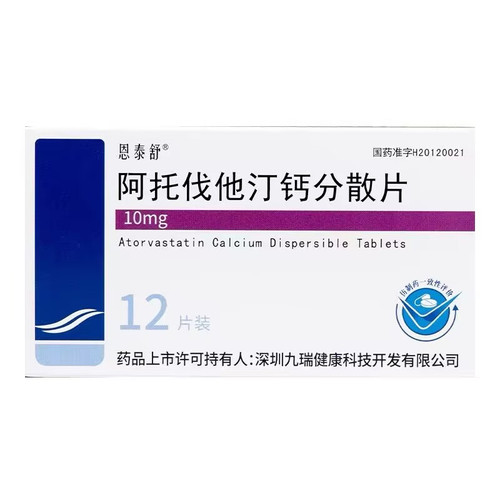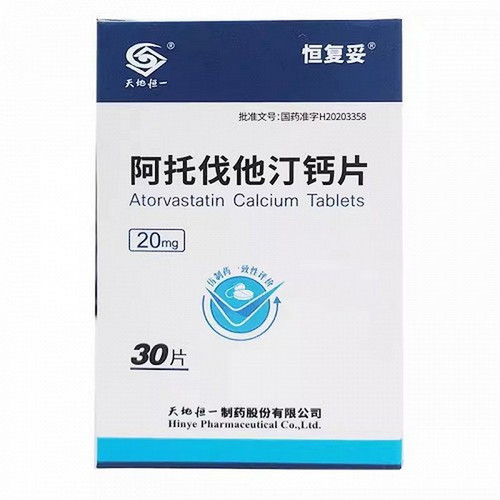Product Overview
[Drug Name]
Generic Name: Atorvastatin Calcium Dispersible Tablets
Trade Name: Jingshu
English Name: ATuoFaTingGaiFenSanPian (JingShu)
Chinese Pinyin: Atorvastatin Calcium Dispersible Tablets
[Ingredients]
Atorvastatin calcium.
[Properties]
This product is a white or off-white tablet.
[Indications]
Hypercholesterolemia; patients with coronary heart disease or coronary heart disease-related critical illnesses (e.g., symptomatic atherosclerotic disease in diabetes) combined with hypercholesterolemia or mixed dyslipidemia.
[Dosage and Administration]
This product can be taken orally orally. It can also be dissolved in an appropriate amount of warm water and then taken orally. Patients should follow a standard low-cholesterol diet before starting treatment with this product and maintain a healthy diet throughout treatment. The dose should be adjusted individually based on baseline LDL cholesterol levels, treatment goals, and the patient's response to treatment. The usual starting dose is 10 mg once daily. Dose adjustments should be made every four weeks or longer. The maximum dose of this product is 80 mg once daily. Atorvastatin can be taken once daily at any time of day, regardless of meals. For the treatment of primary hypercholesterolemia and mixed hyperlipidemia, most patients can achieve lipid control with atorvastatin calcium 10 mg once daily. Significant efficacy is seen within two weeks of treatment, with maximum efficacy seen within four weeks. Efficacy is maintained with long-term treatment. For the treatment of homozygous familial hypercholesterolemia, the recommended dose of this product is 10 to 80 mg/day. Atorvastatin calcium should be used as an adjunct to other lipid-lowering therapies (such as LDL plasma dialysis). Alternatively, it can be used alone when these treatments are unavailable. Dosage in Patients with Renal Insufficiency: Renal disease does not affect the plasma concentration of this product or its lipid-lowering effect, so no dose adjustment is required. (See package insert for other details.)
[Adverse Reactions]
1. The most common adverse reaction to this product is gastrointestinal discomfort. Others include headache, rash, dizziness, blurred vision, and taste disturbance. 2. It may occasionally cause a reversible increase in serum aminotransferase levels. Therefore, liver function should be monitored. 3. Rare adverse reactions include impotence and insomnia. 4. Rare adverse reactions include myositis, myalgia, and rhabdomyolysis, manifesting as muscle pain, fatigue, fever, and accompanied by elevated blood creatine phosphokinase and myoglobinuria. Rhabdomyolysis can lead to renal failure, but this is rare. 5. Concomitant use of this product with immunosuppressants, folic acid derivatives, niacin, gemfibrozil, erythromycin, etc. may increase the risk of myopathy. 6. Hepatitis, pancreatitis, and allergic reactions such as angioedema have been reported.
[Contraindications]
This product should not be used in patients with allergies. Use with caution in patients with allergic constitutions.
[Precautions]
1. Blood cholesterol and creatine phosphokinase should be checked regularly during treatment. This drug may increase serum aminotransferase levels. Patients with a history of liver disease should also regularly monitor liver function tests while taking this drug. 2. If serum aminotransferase levels rise to three times the upper limit of normal, or if serum creatine phosphokinase levels significantly increase, or if symptoms of myositis or pancreatitis occur during treatment with this drug, this drug should be discontinued. 3. If hypotension, severe acute infection, trauma, or metabolic disturbances occur during this drug use, be aware of the potential for renal failure secondary to myolysis. 4. The dose should be reduced in patients with renal insufficiency. 5. This drug should be taken with food to facilitate absorption. 6. Dietary therapy is always the primary treatment for hyperlipidemia. Increasing exercise and weight loss are superior to any medication. Please read the instructions carefully and use as directed by your doctor.
[Use in Special Populations]
Precautions for Children: Not yet available.
Precautions for Pregnancy and Lactation: Not yet available.
Precautions for the Elderly: Not yet available.
[Drug Interactions]
1. Concomitant use of this product with oral anticoagulants may prolong the prothrombin time and increase the risk of bleeding. 2. Concomitant use of this product with immunosuppressants such as cyclosporine, erythromycin, gemfibrozil, and niacin may increase the risk of myolysis and acute renal failure. 3. Colestipol and cholestyramine may reduce the bioavailability of this product; therefore, this product should be taken 5 hours after the former.
[Storage] Store tightly closed.
[Strength] 20mg x 14 tablets
[Packaging] 14 tablets/box.
[Expiration Date] 24 months
[Approval Number] National Medicine Standard H20163163






